Machine base castings made of synthetic quartz may help engineers produce complex shapes, increase tool life, and meet precise tolerances, among other feats.
May 12, 2023
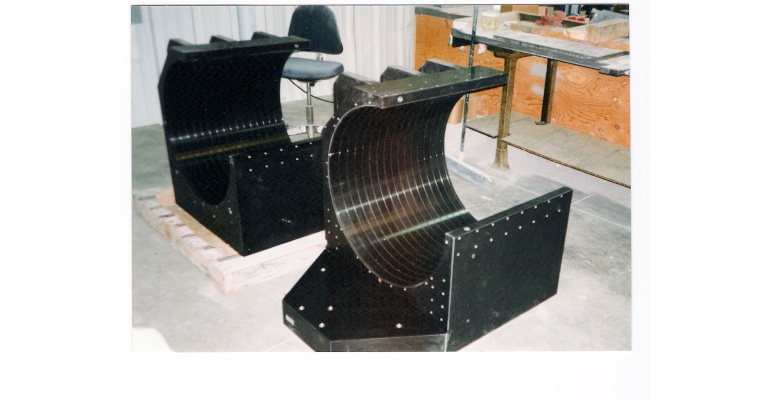
Traditional materials such as cast iron, steel weldments, and stainless steel and aluminum castings are used for the main base structures of machine tools, measuring machines, and pick-and-place equipment. Chip bonders impose limits on the accuracy of this equipment because of their lack of stability and high vibration transmission characteristics. The preferred replacement for these materials is synthetic quartz (SQ) composite castings. Machines of all types are being reengineered to replace metallic structures with SQ castings to reduce costs, reduce lead times, improve machine performance, eliminate painting, improve resistance to aggressive coolants, and reduce the energy consumption to produce the structure. These castings are also used in place of stainless steel for food processing and chemical pump bases.
What Is Synthetic Quartz (SQ) and Why Use It?
It took 20 million years to produce high-purity quartz with MOHS hardness of 8. That quartz becomes 92% of a typical SQ mix. The remainder of the composite is typically a high-strength liquid resin, such as epoxy, polyurethane, or methyl methacrylate with additives for aggregate adhesion and air release.
SQ castings consume 85% less total energy to produce than cast iron and cost less, and they can often be produced to finished tolerances in days. They can be cast in color and offer excellent chemical resistance. The superior vibration dampening characteristics of SQ castings allow machines to operate at higher speeds with greater accuracy and at a reduced noise level.
Empirical claims of 30% to 50% longer cutting tool/grinding wheel life have been reported. Longer cutting tool life means less down time and lower tool cost for the end user. Rapid tool wear can result in parts machined out of tolerance during a production run. Machined part surface finish, tolerance, speed of production, and tool life are directly related to the amount of vibration transmitted within the system.
SQ castings are less expensive to produce, with a typical production time of days as they can often be cast to finished tolerances or subsequently replicated to very precise tolerances. They can be cast in color, eliminating painting and the many associated EPA paint regulations.
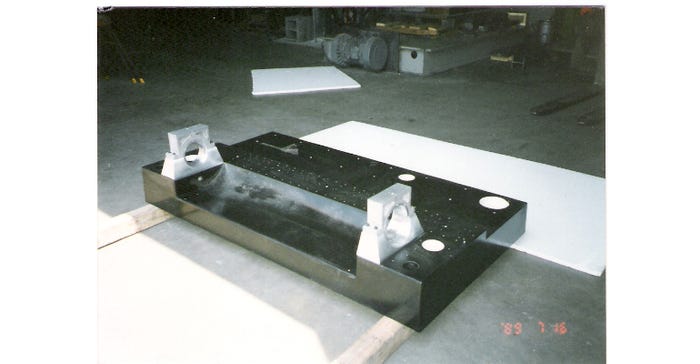
Characteristics of correctly produced SQ include:
Long term stability
Excellent vibration damping
High specific stiffness
Low coefficient of thermal expansion
Ease of manufacture of large, complex configurations
Ability to cast in foam cores hydraulic lines, vacuum lines, pneumatic lines
Ability to cast in plastic drainpipes
Low cost
Rapid production
Cast to tolerance
Although SQ castings can be made using methyl methacrylate (acrylic) urethane or resins, epoxy is the most common resin system used. Epoxy provides high strength and excellent long-term stability and is easy to handle. It also can be used in food contact applications replacing stainless steel.
Epoxy is a stoichiometric formulation and requires precise dosing of the resin to curing agent. An improper mix, with too much or too little curing agent, can result in an uncured mass for years. It is also important to select the correct epoxy resin system for the correct viscosity, cure rate, stability, strength, and cost. The formulation can be modified to provide very quick curing or be slowed to take several hours when casting a large mass to reduce exotherm.
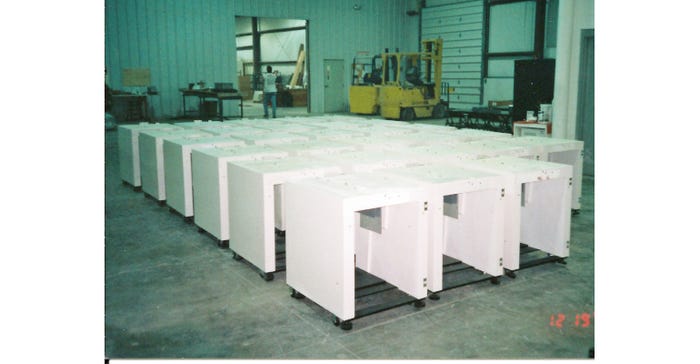
To produce the proper SQ mix, the system must take into account:
Choice of filler
Shape, cleanliness, and dryness of aggregates
Proper packing design of the aggregates
Strength and stability of the resin system
Viscosity and wetting ability of the resin system
Exothermic reaction time and temperature, which is mass dependent
Ability to properly mix dry components
Ability to achieve a homogeneous process mix
Maximized consolidation during vibration based on part size, configuration, vibration amplitude and frequency
Control to the casting environment
SQ Part Design Considerations
The first thing a designer needs to do is forget just about every rule of thumb they know about machine structure design. They should think freely about what features would produce the best structure for their application. And they should no longer be constrained to consistent wall thicknesses. Wall thickness can go from 1 to 12 in. in the same area without a negative consequence. Plastic tubing or hydraulic lines can be cast into the base, so there would be no more running lines around the outside of the base on the assembly line.

One of the most challenging parts ever cast is an 18-in.-diameter, 270° drum with eleven 1-mm-deep vacuum grooves. (Please see image at top of page.) This casting has a 0.001 TIR on the bore. The vacuum grooves end 25 mm before each end, so the tooling needs to be pulled out of the part—it cannot be rotated out. Each vacuum groove exits out the rear of the casting to a manifold. Parts can be produced in two days that would take several months to produce as a cast iron or cast aluminum part, and the SQ casting costs a fraction of any other method.
Parts that need to be separated as metallic pieces may now be able to be cast as one, saving assembly time, but also reducing the required tolerance of the components.
The other design feature available only using this technology is the ability to cast parts to tolerance. Surfaces can be cast to precise flatness, hole diameters, and locations. Once a mold has been verified, casting dimensions will consistently be the same, so inspection is reduced. Way surfaces can even be cast to tolerance or precisely replicated.
Tapped holes are threaded inserts cast in place. Tapped holes cannot be missed or unthreaded as each threaded insert is held to the mold by inserting a bolt to be cast into the part.
Another unique feature of SQ is the ability to cast surfaces with different properties in the same casting. One grinding machine manufacturer casts low-friction way surfaces on their cross slide when the part is cast. This surface offers excellent long-term wear and very low friction.
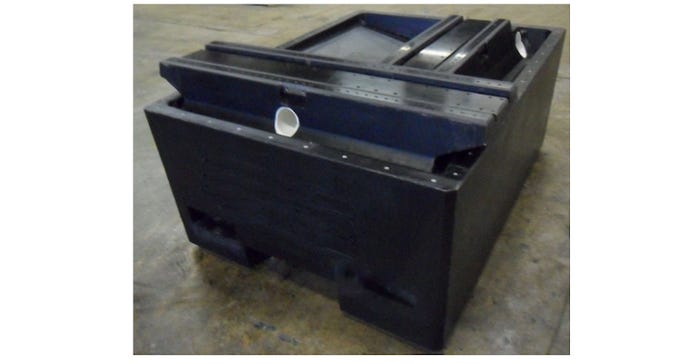
Drain systems can be cast in using standard PVC pipes. Foam cores can be cast in to reduce weight with little impact on the stiffness. Because of SQ’s excellent chemical resistance, tanks can be cast as part of the assembly, and SQ can be used in place of stainless steel in many applications.
Parts that cannot be cast to tolerance can have precision surfaces created after casting by replication. In this process, a precise master is created that will be used to create the precision surface. The replication material is then applied, and the precise master is located against the casting at a preset distance. After curing, usually 24 hours, the master is removed, and the surface created is an exact copy of the master. It can be a precision way surface for mounting rails or a low-friction surface for direct contact with a moving slide.
Material Properties
The table below shows the basic properties of the CASTINITE HS Standard Mix SQ material:
Mechanical Properties | US | Metric |
Compressive Strength | 18,000 psi | 124 N/mm2 |
Tensile Strength | 3,500 psi | 24 N/mm2 |
E Modulus | 4.5 x 10^6 | 31 kN/mm2 |
Poisson Ratio | 0.29 | 0.29 |
Density | 0.083 lb/cu in. | 2.3 g/cm3 |
Thermal Expansion | 7.6 x 10^-6/F0 (in./in.) | 16 x 10^-6/K0 (m/m) |
Thermal Conductivity | 11 Btu/(hr*ft2*0F/ft) | 0.191 W/(cm2*0K/cm) |
Damping Ratio | 0.16 | 0.16 |
Specific Heat | 0.23 Btu/(lb*0F) | 960 J/Kg*0K |
Maximum Working Temperature | 250°F | 120°C |
Minimum Working Temperature | -50°F | -45°C |
Tooling Considerations
SQ castings are produced at room temperature and pressure, so molds can be made of wood, fiberglass, sheet metal, steel, or plastic. Wood molds are the least expensive but will not produce precise parts without using a secondary operation. If wood molds are designed, manufactured, and treated properly, they can produce numerous castings. If not designed properly or not handled properly during casting, they will make one bad part.
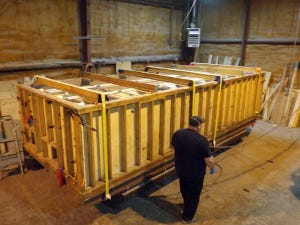
Wood mold (left) for 45,000-lb LB grinder base (right).
To produce a quantity of precise castings to close tolerances, steel production tools are necessary. With properly designed steel molds, parts may be cast to tolerance without secondary operations, production times will be lower, and parts will have a much better surface finish.
SQ castings have found use in many other applications including countertops, gravestones, trench drains, and chemical pump bases. NASA has been testing them for use in energy storage.
Conclusion
If you are looking to lower your cost, lower your carbon footprint, and improve your machine’s performance, SQ may be the answer.
About the Author(s)
You May Also Like




